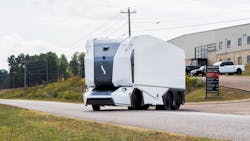Kodiak's autonomous electric truck a preview of trucking's future
Though autonomous and battery-electric trucks have evolved separately over the past five years, the logical conclusion was that these synergistic technologies would someday combine to move freight more efficiently and sustainably. That future is closer than ever following Kodiak Robotics revealing its autonomous Class 8 electric truck at ACT Expo on May 2.
The Peterbilt Model 579EV electric truck was upfit with Kodiak Driver, the company’s self-driving technology, along with fifth-generation sensors. Kodiak expects the autonomous electric vehicle (AEV) to join their fleet in 2024. Last year, Werner Enterprises piloted Kodiak’s diesel trucks over 152 hours and accomplished a 100% on-time delivery rate. U.S. Express has also completed Level 4 autonomous operations, where a safety driver is present, with Kodiak, with a March pilot spanning 6,350 miles. Swedish furniture retailer IKEA has also tested these self-driving trucks within its supply chain operations.
“We’ve been interested in sustainability and zero-emissions technology for a long time,” Andreas Wendel, Kodiak Robotics’ CTO, told Fleet Maintenance before the truck’s unveiling. “A lot of our employees drive electric, even hydrogen, vehicles. It’s where we think the freight industry will go over time. At the moment, a lot of these vehicles are very short-range—but that doesn’t prevent us from actually starting to integrate and show the future benefits.”
Because the range is 150 miles, it will be used for short-haul and drayage for now. Kodiak noted a study that found autonomous technology improves fuel efficiency by 10%, and that would inherently improve range on an AEV as well.
“Combining electric technology with autonomy will lead to safer, more environmentally-friendly outcomes, regardless of how and where self-driving vehicles are deployed,” Wendell said.
He noted as with all technology, electric truck batteries and fuel cells will advance and have increased capacity over time.
“The miles they drive will actually change—it will get more over time—be it with battery-electric vehicles or fuel cell-electric vehicles,” Wendell said. “But for us, it’s really to show the adaptability of our Kodiak Driver system, both the hardware and software to integrate on these vehicles.”
Any vehicle truck technology will have to adapt to zero-emission platforms to remain relevant in the coming decade. On the federal level, U.S. Environmental Protection Agency will start enforcing stricter emissions regulations in 2027, and on the state level, California Air Resource Board approved a sales ban on diesel trucks starting in 2036. Several other states are also imposing gradually capping diesel commercial vehicle sales.
“We believe that the future of trucking is the combination of electric and autonomous vehicles,” asserted Don Burnette, founder and CEO of Kodiak Robotics in a press release announcing the new high-tech truck. “Given advancements in battery and fuel cell technologies, achieving zero-emissions trucking will soon be within reach. Kodiak’s work on the Peterbilt Model 579EV will help us gain valuable experience in how to build autonomous electric vehicles and help us realize that vision. Customers have been long asking for an autonomous electric vehicle and we are delivering on that need.”
Overcoming range limitations
A future where self-driving trucks silently zoom down America’s highway on battery power alone is still far off. Even though an SAE Level 4/5 truck wouldn’t be beholden to driver hours of service requirements, the self-driving truck will still be limited by battery capacity.
The Peterbilt Model 579EV, and many of its competitors in the heavy-duty EV space, have a range of about 150 miles. At a constant rate of 60 mph, the truck can go at best 2.5 hours between charges. That’s 150 miles every 5.5 hours when factoring in the three-hour charging time. In 24 hours, the truck might be able to travel up to 654 miles. That’s at best and not factoring in city speed limits and traffic or waiting in line for a charger. And then there’s dwell time waiting to pick up and drop off trailers.
A human truck driver travels over 600 miles per day no problem, and does it in about eleven hours of driving. For autonomous trucks to be cost competitive, they need to operate far longer than a human driver would each day. This would be more plausible when fuel cell technology, which provides a far greater range than current battery-electric systems, matures over the next five years.
Modular maintenance
Battery-electric trucks have one obvious advantage over diesel trucks: no need for emissions systems. No diesel exhaust fluid, no diesel particulate filters and no forced regenerations.
But electrical systems are not immune from failures and faults, and can be complicated to troubleshoot. On top of that, fleets will also have to contend with issues related to the autonomous system’s lidar and radar sensors, and cameras. These need to be perfectly calibrated and failure-proof if they are ever to operate without a driver behind the wheel.
Kodiak is well aware of this.
“Replacing individual sensors would normally require a technician with specialized equipment to diagnose a sensor issue, and a highly-trained technician to replace an individual AV sensor,” Wendell explained. “This issue is amplified in more remote areas where specialized technicians aren’t readily available, but where long-haul trucks often travel.”
According to Wendell, Kodiak designed the truck to specifically combat maintenance unknowns.
“To address this, we introduced our proprietary SensorPods, which are modular units that house multiple sensors and can be completely removed and easily replaced by a mechanic without specialized training,” he said, adding this can take about 10 minutes (see video below). “This ultimately increases truck uptime and clears an important hurdle to commercialization.”
The SensorPod replaces what Wendell called the “unibrow sensor suite” found on most autonomous truck cabs, and allows for “faster upfitting for customers, greater maintainability and serviceability, and better perception capability.”
Drayage and AEVs
Swedish company Einride is also developing AEVs for the U.S. and Europe. Last year in Tennessee, the company's self-driving electric trucks transported goods between a GE Appliances' plant and warehouse without a safety driver onboard, which was an industry first in the U.S., according to Einride.
This year, Einride will be launching an electric charging network near the Port of Los Angeles to support Maersk. The shipping company made a deal to purchase 300 Einride AEVs over the next five years.
While Kodiak’s Model 579EV can be used in drayage, the company isn’t currently focused on that application and more keen on long haul. Wendell did offer that autonomy could make sense in drayage.
“There are certainly opportunities to use AV technology to help drayage drivers manage long lines at ports,” he said. “Driverless operations at ports could potentially improve driver quality of life by getting them out of line and on the road in complex, local routes."
About the Author

John Hitch
Editor-in-chief, Fleet Maintenance
John Hitch is the award-winning editor-in-chief of Fleet Maintenance, where his mission is to provide maintenance leaders and technicians with the the latest information on tools, strategies, and best practices to keep their fleets' commercial vehicles moving.
He is based out of Cleveland, Ohio, and has worked in the B2B journalism space for more than a decade. Hitch was previously senior editor for FleetOwner and before that was technology editor for IndustryWeek and and managing editor of New Equipment Digest.
Hitch graduated from Kent State University and was editor of the student magazine The Burr in 2009.
The former sonar technician served honorably aboard the fast-attack submarine USS Oklahoma City (SSN-723), where he participated in counter-drug ops, an under-ice expedition, and other missions he's not allowed to talk about for several more decades.
Cris Beaulieu
Cris Beaulieu is an Associate Editor for Fleet Maintenance magazine. She joined the team after working in local news media. She earned a bachelor’s in journalism at Cleveland State University along with a TV and Radio Broadcast degree at Ohio Media School.



